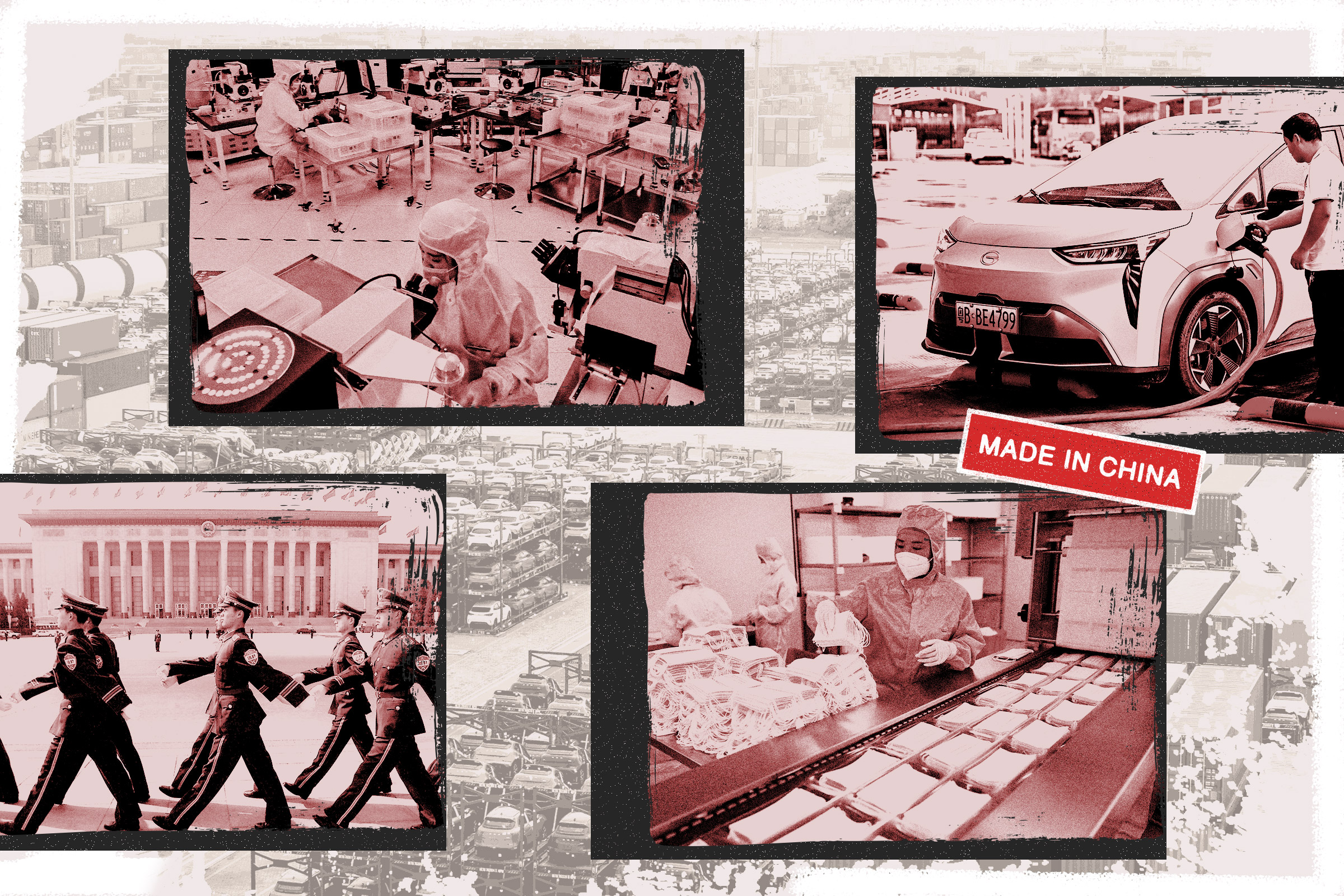On May 14, the Biden administration announced its intent to significantly increase tariffs on Chinese electric vehicles (EVs), chips, steel and aluminum products, lithium-ion batteries, solar cells, and medical supplies.
According to White House officials, the tariff hikes apply to about $18 billion of annual imports from China and will increase to up to 25 percent—triple the current level—on a stacked schedule between 2024 and 2026.
Officials also said all existing tariffs levied during the Trump administration—on about $300 billion of goods from China yearly—will remain in place, if not increase.

U.S. Trade Representative Katherine Tai said supply chain dependency on China makes the entire U.S. economy “susceptible“ to coercion from the Chinese regime, which is ”willing to weaponize the dependencies.”
The new tariffs don’t apply to imports of Chinese brands shipped from a third country, such as Chinese EVs produced in Mexico. Ms. Tai told reporters on May 14 to “stay tuned” on that issue, suggesting that the administration may take further action.
“The whole idea that you could have unlimited open trade with China and there was no risk is gone,” James Lewis, director of the strategic technologies program at the Center for Strategic and International Studies think tank, said.
The Biden administration, he said, has done a good job of recognizing that technology and economics are as important as, if not more important than, traditional military power and of recognizing the need to restrict China’s access to them.
“Those are the two biggest things: rebuilding partnerships to support a rule-based order and choking back on technology linkages with China,” Mr. Lewis told The Epoch Times.
Lael Brainard, director of the National Economic Council, told reporters in a call ahead of the announcement that the tariff increases are consistent with President Joe Biden’s policy of “responsibly managing competition with China.”
She said the administration is working with other countries to “address ... shared concerns about China’s unfair practices.”
“China’s using the same playbook it has before to power its own growth at the expense of others by continuing to invest, despite excess Chinese capacity and flooding global markets with exports that are underpriced due to unfair practices,” Ms. Brainard said.
“China’s simply too big to play by its own rules.”
Stephen Ezell, vice president for global innovation policy at the Washington-based Information Technology and Innovation Foundation think tank, told The Epoch Times that the tariff hike “certainly shows that the Biden administration is willing to get tougher on China ... especially in advanced technology industries that are very important to U.S. economic and national security.”
He said the new tariff policies represent “a significant strengthening of the Biden administration’s China position from certainly where they were at the start of their administration.”
During his 2020 presidential election campaign, President Biden criticized the tariffs President Donald Trump implemented on Chinese goods and vowed to remove them if he took office. However, he has retained them all.
Christopher Balding, an expert on the Chinese economy at the Henry Jackson Society, a UK-based think tank, said the new tariffs are “very understandable” because tariffs are a tool in a limited toolbox when addressing China’s unfair trade practices.
Both Mr. Ezell and Mr. Balding said they consider the tariff increase as a step in the right direction, but tariffs are only part of a larger strategy.
Mr. Ezell said he would like to see a “coherent, grand geopolitical strategy” for how the United States and its allies deal with the China threat.
“I think an overall strategy that is joined up between economics, national security, and trade policy is still lacking from this administration,“ he said. ”I’d like to see them do that.”

Choking China Off
In addition to shortages of medical supplies, the COVID-19 pandemic revealed the United States’ dependence on China for chips—which power everything from smartphones to fighter jets. Government lockdowns during the pandemic led to shipping delays and port congestion, which drove down supply. U.S. domestic auto manufacturing also slowed because of a lack of microchips.Bolstering domestic semiconductor capacity is a key plank in the Biden administration’s bid to “outcompete” China.
At the same time, the White House has escalated national security efforts to block the flow of sensitive technology to China.
In October 2022, the administration issued sweeping new export controls to restrict China’s access to advanced semiconductor chips made with U.S. technologies, regardless of whether the chips were manufactured in the United States. The aim was to block the Chinese military’s access to this critical technology at the heart of advanced weapons systems.

“We’re slowing down China’s ability to design nuclear weapons,“ he said. ”That’s a win for U.S. export control.”
A landmark investment is a $100 billion chips manufacturing campus in central New York by Micron Technology Inc. Last month, the company secured a $6.1 billion federal grant for the project.
However, government-chosen winners may or may not win in the market, according to William Lee, chief economist at the Milken Institute, an economic think tank based in California.
Years of heavy subsidies in China make competing with those state-sponsored companies difficult.

“Every administration, whether it’s Biden or Trump, or whoever wins the next one, if they want to fight competition from China by subsidizing or creating more onshoring, they will have to spend a lot of money, because right now, there are hardly any American producers,” Mr. Lee told The Epoch Times.
Network of Alliances
On the diplomatic front, Ray Powell, a director at the Center for National Security Innovation at Stanford University, said the Biden administration deserves credit for achieving what the United States has wanted to do for a long time: build a tight network of allies.“Take our alliance relationships, especially those in the Indo-Pacific, from the hub and spoke model, where the U.S. is the hub and each of the alliances is a separate spoke, and turn it into a latticework, almost like a mesh,” he told The Epoch Times.
The Trump administration’s 2017 National Security Strategy pivoted away from the global war on terror to focus on competition with China and Russia, a direction the Biden administration continued. President Trump’s strategy set out to strengthen alliances in the Indo-Pacific region, and President Biden has taken it further.
The Chinese regime, which illegally claims almost the entirety of the contested waterway, has built a network of artificial islands with military installations in the region. Chinese vessels have taken increasingly aggressive actions toward ships from neighboring countries, particularly the Philippines.

Economic partnerships formed in conjunction with security programs. The United States will open a development bank branch in Manila and is in talks with the Philippines about a partnership for its global infrastructure and investment initiative—the United States’ global infrastructure program countering China’s Belt and Road Initiative.
In addition to Asia, the administration has built a series of global partnerships, including AUKUS, which is a trilateral security partnership with Australia and the United Kingdom, and the U.S.–EU Trade and Technology Council.
Created during the Trump era, the Quad, or the Quadrilateral Security Dialogue with Australia, India, and Japan, held its first-ever meeting under the Biden administration in March 2021.
“It’s not a global alignment against China, but it is a willingness to say, ‘If you had to pick, you pick the United States before you pick China,’” Mr. Lewis said. “And that’s a major problem for the Chinese.”
Mr. Lewis said people tend to underestimate how those wars influenced how China, Iran, and other foreign adversary countries view the United States and its power.
“So Biden had to rebuild,” he said.
Is the Latest Move for Votes?
The experts have differing opinions about the extent to which President Biden’s tariffs on China are for attracting votes in this year’s presidential election.However, they agree that, vote-grabbing or not, President Biden is carrying out his China policies at a time when American public awareness of the China threat has reached a whole new level compared with four years ago.

Mr. Balding said he doesn’t think foreign policy will dominate voters’ minds in the presidential election. However, he said, “It’s very clear people see the world as a more dangerous place now than they did four years ago.”
Mr. Ezell said the administration’s moves are both aimed at taking a more resolute position against China and getting more votes in the election.
Mr. Lewis held a different opinion.
Pushing back on China, he said, has been a “consistent theme” of members of the Biden administration’s national security brain trust since even before the 2020 presidential election.
“There was a realization that the old structures and the old security threats didn’t reflect what was really going on,“ Mr. Lewis said. ”I think that’s where the Biden people would say they’re trying to modernize American foreign policy.”
Mr. Lee said the $18 billion new tariff base is negligible compared with the $300 billion base of the existing tariffs. He said the move is purely for votes in the upcoming election.
However, he credited President Biden with returning to a more traditional Democratic platform, which supports workers and their rights. He said President Trump took that platform and expanded it to include U.S. jobs.
“Biden and Trump are singing the same China tune,“ Mr. Lee said. ”It’s just that Biden is in the first and third stanzas, and Trump is in the second stanza. It’s the same song.”



















